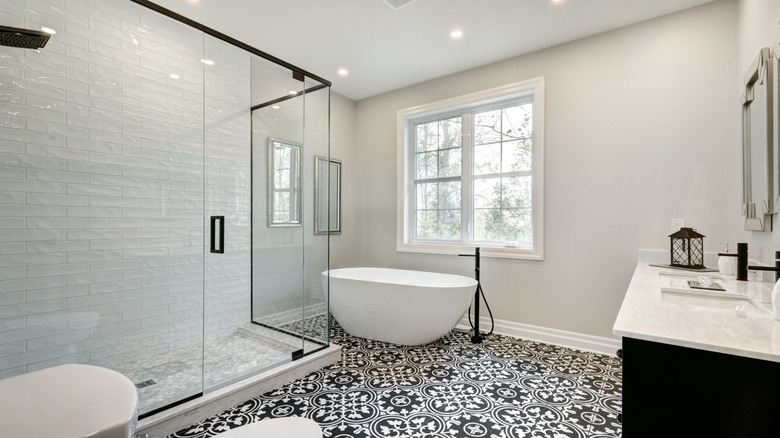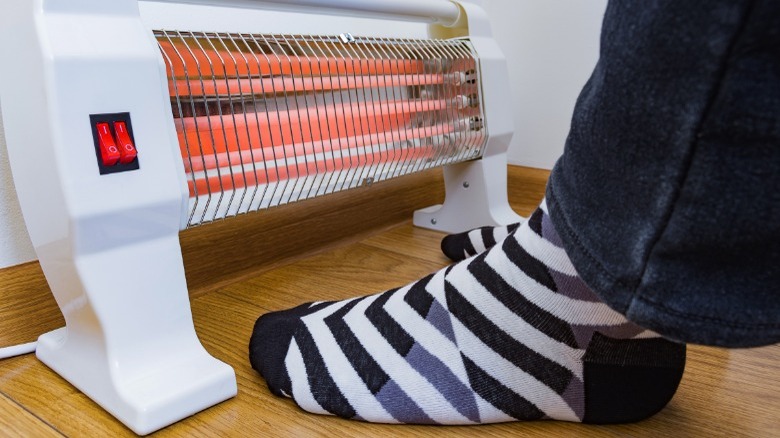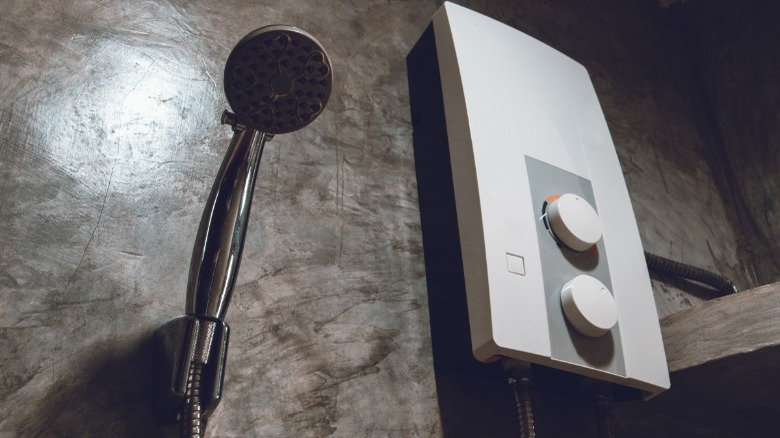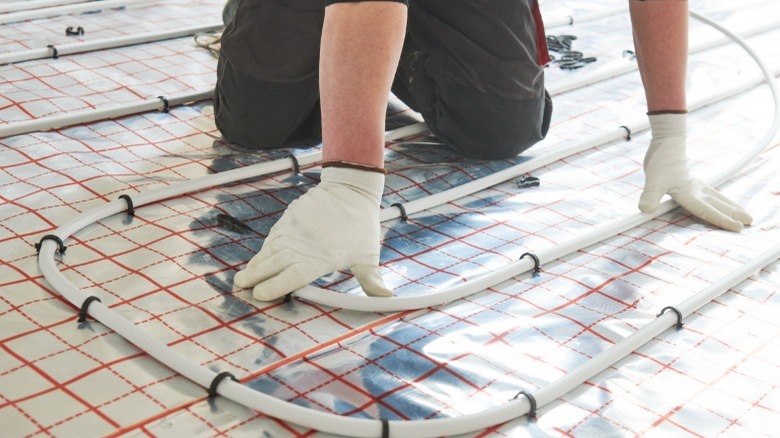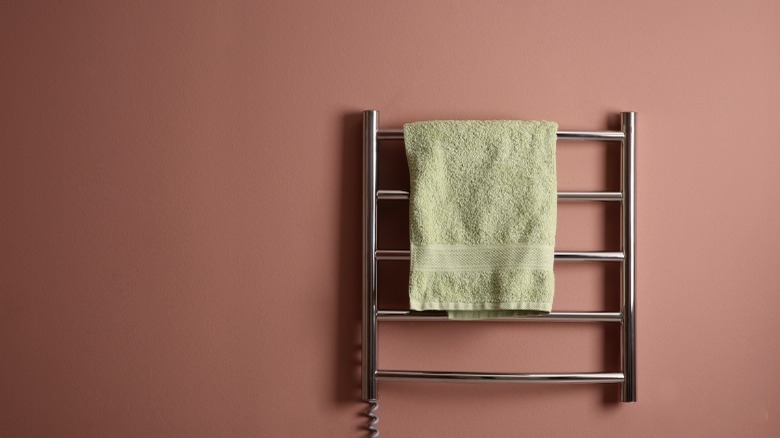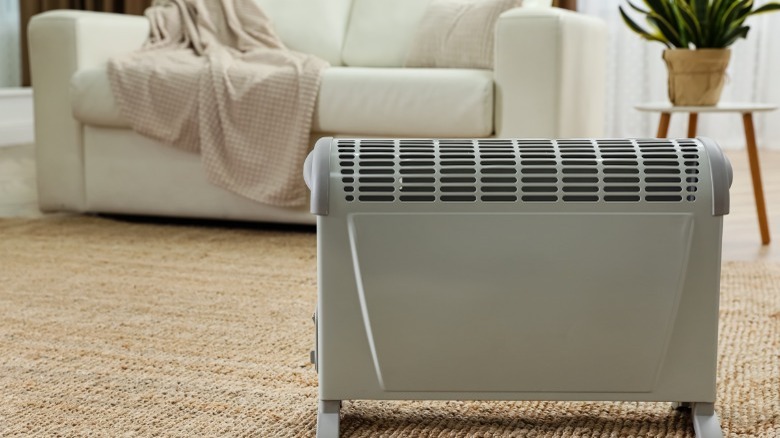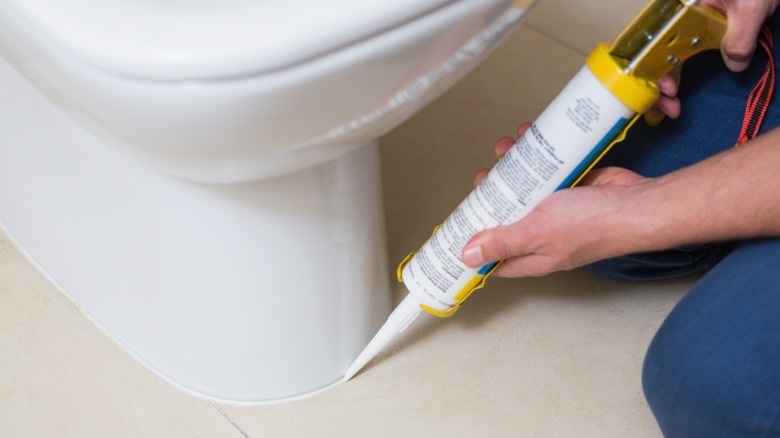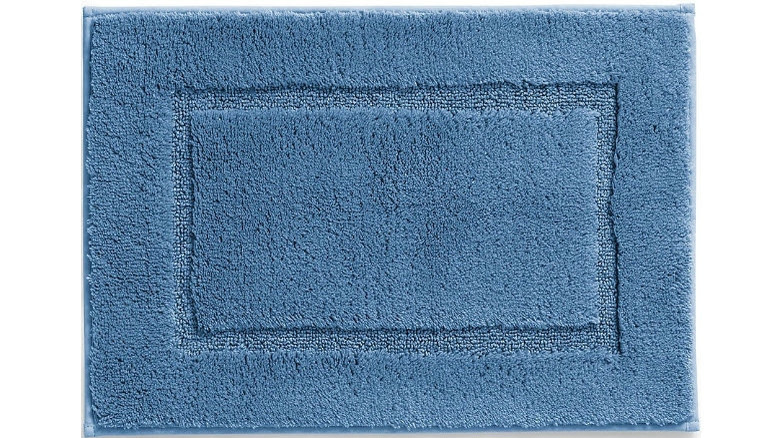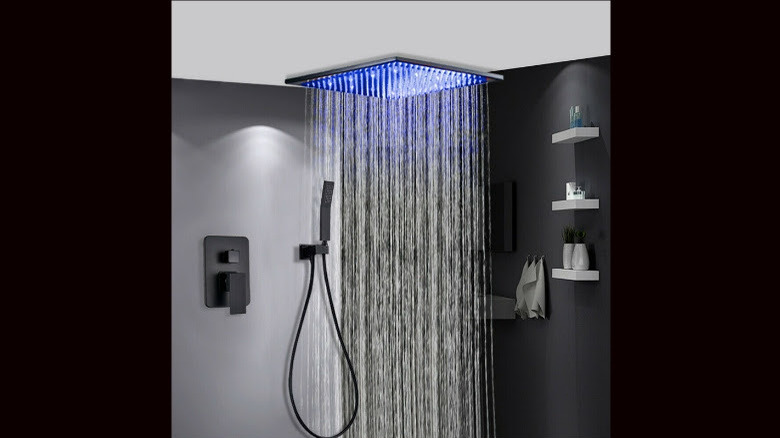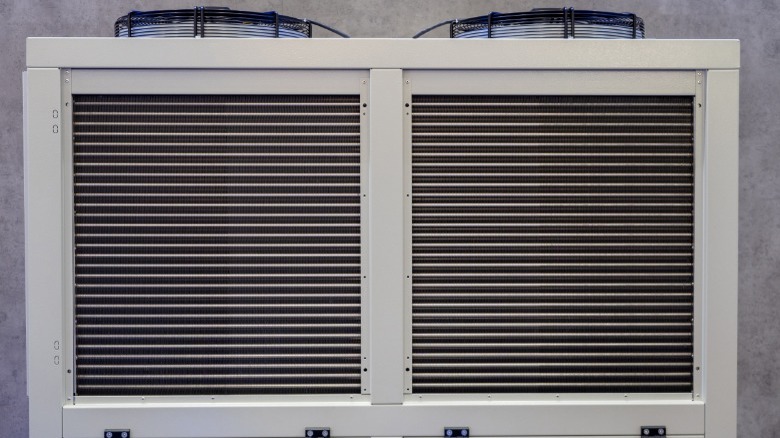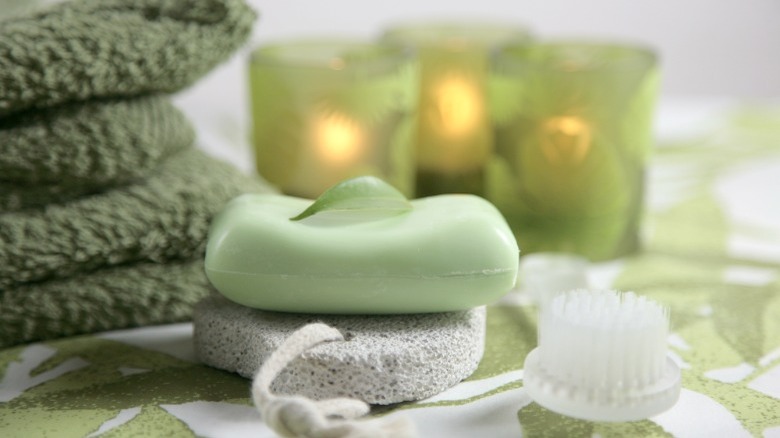Heat Up Your Chilly Basement Bathroom With These Simple Tips
Basements are notoriously cold, especially basement bathrooms. We all know hot air rises, and this inherently leaves cooler air in the basement. But what else contributes to the perpetual drafty climate in your basement? For one thing, most homes in America are under-insulated. This is one of the core issues of chilly basements. Another is in the foundation, which has tiny holes in it that allow air to come in. In fact, any gaps that allow air to get in your home or poorly insulated areas contribute to the stack effect. As we already discussed regarding hot air rising, it does this because it has less density than cool air. If any cool air from outside is getting in, it creates a vacuum and convection current that keeps your basement chilly and drafty.
There can also be other contributing factors, like an inefficient HVAC system and humidity in the air. One trick you can try if your basement is particularly damp and cold is a dehumidifier. Another trick is to leave your furnace fan on, which helps force cold air to move up and circulate with the warm air to blend more thoroughly throughout the house. These are small things but helpful in taking the chill out of the air. Still, basement bathrooms are likely to remain the most dreaded room in the house when it comes to being cold. We've put together some research to give you some great ideas for how to heat up your chilly basement bathroom with these simple tips.
Plug in an electric heater
Probably the simplest and quickest way to temporarily warm up the basement bathroom is to plug in an electric space heater. In this case, we'll discuss radiant heaters, which are the kind of electric heaters that radiate heat outward through electromagnetic waves. This type of space heater works by heating surfaces and objects around it and is generally believed to be quicker and more efficient than other types of space heaters. However, you should not leave them running unattended.
Still, for taking off the chill in a small space like a basement bathroom they do the trick quite well. The only problem is that you have to go in ahead of time and get it running for about 10 minutes. Then, when you're finished, you have to remember to turn it off again. It's a temporary and superficial fix to the problem, but effective in a pinch. There are many different kinds of electric space heaters to choose from, so do your research before purchasing one.
Install a wall heater
One of the best ways to heat up the small space of a bathroom is to install an electric wall heater. When you're trying to warm up a chilly basement bathroom, you're likely working in fairly cramped conditions as it is. So using a standard electric space heater is even less of a viable solution, and can even be a hazard. A better idea is to install a more permanent heating option like a wall heater.
Though there are a variety of models of wall units, you'll likely need to cut out a section of the wall to fit the unit into and run the electricity to it. Many models have a built-in thermostat to keep the temperature regulated. The project itself can be done as a DIY, or you can have it done by a professional if you prefer. Installing a wall unit like this represents a more permanent solution to your chilly basement bathroom.
Install heated flooring
If you plan to use the basement bathroom often and it's a good size area you want to heat, you might want to consider radiant floor heating. As most of us can attest to, walking barefoot on a cold tile floor in the wintertime is unpleasant to say the least. The basement subfloor is made of concrete, which can make the floors seem perpetually cold. Ideally, radiant floor heating should be installed before finishing your basement for living space. If you wait until after finishing it, it's a much bigger project because it involves ripping out the existing flooring.
There are two kinds of basement floor heating systems: hydronic and electric. If you have an existing finished floor in the basement, an electric system is simpler to incorporate and less expensive than a hydronic system. They can be installed underneath most floor types including tile, stone, and hardwoods, and don't use any pumps or boilers for operation. Hydronic radiant floor heating uses hot water to heat the floors, and there is a pump and boiler involved that make the initial costs to install it higher. However, the efficiency of this system is up to 30% better than electric systems, making the energy costs to run it that much less. If you're interested in heating your basement bathroom floor, speak to a professional who can tell you which option will work best.
Heated towel racks
Another neat trick to help give you an incentive to use that cold basement bathroom is to install heated towel racks. This may sound like a luxury strictly reserved for the rich but in actuality, a quick Google search reveals their average price to be in the $100 to $150 range. Not too bad for something you otherwise might never have thought to look into. Aside from their initial perhaps ostensible purpose, however, these heated towel racks can actually go a long way towards warming you up.
If you've had the pleasure, you already know how nice it truly is to have a warm towel at the ready when getting out of the shower, especially in a drafty bathroom! Heated towel racks are easy to install and plug into an existing electrical outlet in the room. They heat up quickly and evenly and remain energy efficient. You can choose from a single bar rack to a multibar design and from different sizes and finishes. Every little bit helps!
Use a convection heater
Going back to space heaters for a moment and really, another choice of heating types in general, is the convection heater. This type of heater works by taking the cold air in the room and sucking it inside to warm it up, then recirculating it and blowing it back out. It warms the air itself, but it takes a bit longer to work since air is a poor conductor of heat. They're good for small spaces like the typical basement bathroom, but in this case, you'll need to start the heater about 20 minutes before you plan to use it.
There are five different types of convection heaters: fan heaters, oil and water heaters, furnaces, and ceramic heaters. They work well for heating the air uniformly in a small space, and will definitely take the chill out of your basement bathroom. You have many different models and types to choose from in this department, so do your due diligence in research before buying anything. Fan and convection heaters are considered two of the safest forms of space heating options.
Use infrared heat lamps
Another great idea for how to help warm up your chilly basement bathroom is with infrared heat lamps. These lamps work to heat small spaces quite well, but they do require a lot of energy so you may have to use a different circuit. There are of course a myriad of different options here, but it can be an economical alternative to traditional space heaters.
Heat lamps are also often called infrared heaters. The term heat lamps is really a bit misleading, since they're primarily used for heating and not really for lighting purposes. Typically you install a heat lamp above the vanity in your bathroom ceiling. They can have one bulb or two, depending on if you have any space limitations. The bulbs they use can be either infrared or incandescent, or both. You can also choose a combination heat lamp and exhaust fan. They are particularly efficient in bathrooms and small areas and are a cost-effective alternative to other types of space heaters.
Seal cracks with caulking
When you're looking for a more fundamental solution to the problem of a cold basement bathroom, a good tip is to start by using caulking to seal up any cracks and crevices. Silicone or bathroom caulking will work just fine, just make sure you choose mold-resistant caulk. You'll want to go around everything in your basement bathroom and check for any cracks in the wall around fixtures, along baseboards and ceilings, and around any exhaust fans or windows. Anyplace plumbing comes through the walls or flooring, and even around all your permanent fixtures (sink, toilet, tub, etc.).
The idea is to seal out any possibility of air coming through any cracks. At the same time, you will be helping to waterproof these areas. The better the room is sealed up overall, the better the warmth you generate inside of it will be contained. Remember to get around the ceiling where any tile meets the top and where any tile meets the walls or the baseboards, as well. Make sure you wait the full amount of time recommended for it to dry before using the bathroom again.
Put thick rugs down
When you're dealing with a chronically cold basement bathroom, in lieu of radiant floor heating you can put down some thick padded non-stick rugs. Having nice thick, soft rugs under your feet in a cold bathroom makes a big difference. Finding the right material and washability factor can be tough, plus you want the rugs you put down to be non-stick. There are an endless variety of bathroom rugs to choose from.
According to the NY Times Wirecutter, one of the best rugs you can buy for this purpose is the Land's End Premium Supima Cotton Bath Rug. These rugs are made from a special rare cotton grown in the U.S. called Supima, which is in the top 3% of all cotton grown here. They're available in 12 different colors and four different sizes, plus a contoured rug for placing around the toilet. Prices start at $39.95 for the small size 16" X 23" rug. These rugs also have a non-skid backing that grips the floor well. The rugs are absorbent but also dry out again quickly, and they stand up to being machine washed and dried without falling apart.
Install a larger rain shower head
Another great tip for staying warm is to opt for a larger rain shower head in the basement bathroom shower. You might as well get the most hot water coverage when showering, so why not choose the large diameter of a rain shower head? The size of the surface area of these shower heads is anywhere from 5" to 18" inches in diameter. This makes it feel more like it's raining on you than the normally much smaller, focused area of a regular-size shower head.
Some people don't like the fact that these shower heads don't have as much water pressure as smaller shower heads do. This is due to the multiple nozzles where water comes out, which distributes the pressure instead of concentrating it. But they're typically mounted higher up or on the ceiling so that gravity builds the pressure as it falls. Many people fall in love with the luxurious feeling akin to showering underneath a waterfall. There are all different kinds available, like the Rozin Ceiling Shower Head Faucet measuring 16" X 16" square, sold for $143.99 at Wayfair.
Install an electric ceiling panel heater
Another type of small space heater that works excellently for the bathroom is the ceiling panel heater. This is an extremely efficient way to warm up that chilly basement bathroom without taking up any extra space. There are multiple different types, and they only take up about as much space as an exhaust fan. In fact, some are even built as a combination heater and exhaust fan.
For example, one option is the Dayton Electric Ceiling Panel Heater sold by Grainger for $299. It can be either recessed or ceiling surface mounted and uses radiant heat. It operates with a wall-mounted thermostat by remote control and is extremely efficient for heating up a basement bathroom. Another option from Walmart is the King Electric Ceiling Heater for $278.08. This heater works with a NiChrome open coil element and has a whisper-quiet operation. This model comes with a 3-year limited warranty.
Create visual warmth
Visual warmth is more important to maximizing actual warmth than you might think! Even if your basement bathroom is still a bit chilly at first, there are some visual cues that elicit warmth that can actually help the overall feel of the room. For example, put some houseplants that can survive in low-light conditions in your basement bathroom. There are even certain varieties like ferns that also work to regulate humidity and fight mold spores! Plants can make any space seem more tropical and warm.
Additionally, use warm color schemes in your chilly basement bathroom. Try earth tones or even an olive green color to give some extra warmth to the space. You could even try using yellow light bulbs instead of white to mimic sunlight. Candles make the room seem warmer, so perhaps try some electric candles for added ambiance. The more visual cues that signify warmth the better. You might be surprised at how much power your mind has over your body's initial reaction to temperature. Hopefully, these tips on how to warm up your chilly basement bathroom have given you the inspiration you need to tackle yours!
